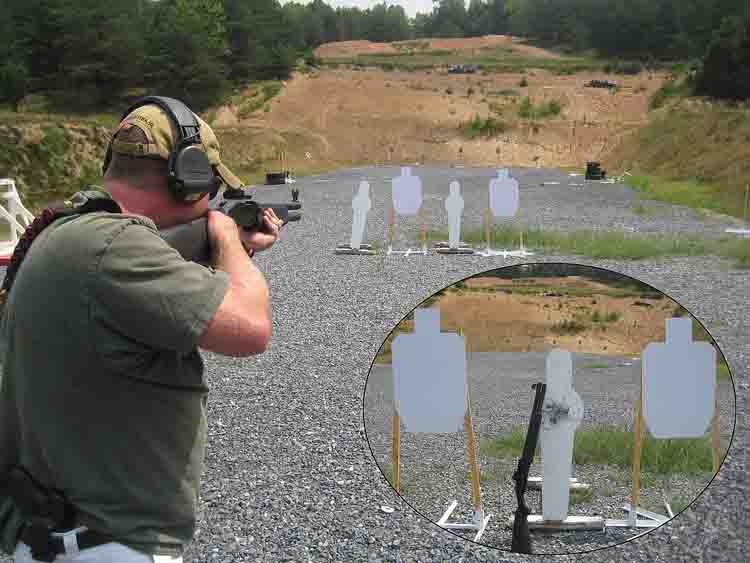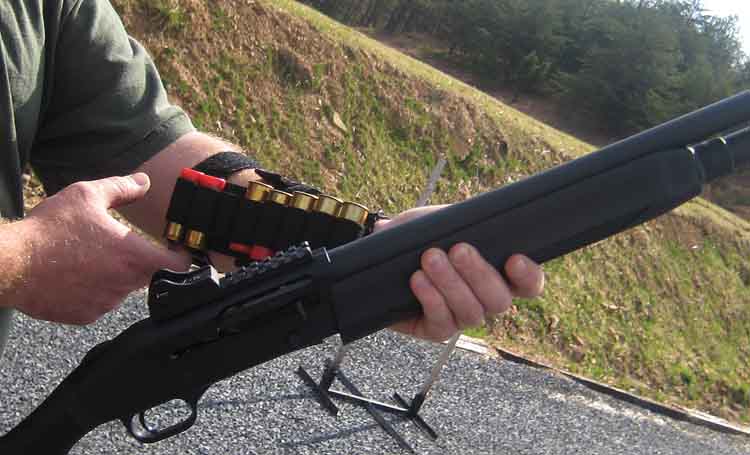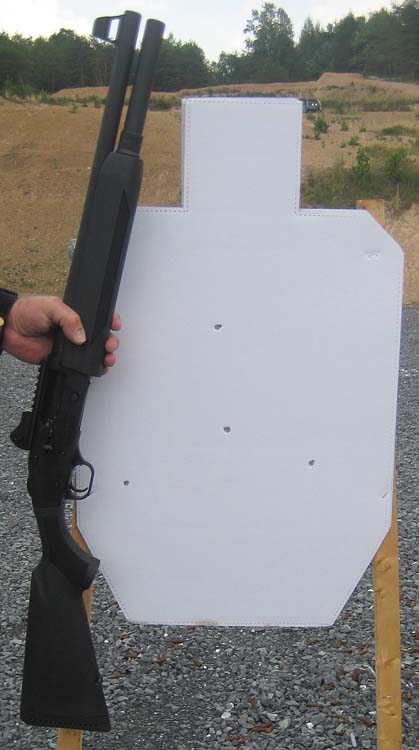The combat shotgun has been around for centuries dating well back to muzzle loading era. Early shotguns pressed into a martial role probably served dual roles as a close range weapon and sporting piece for fowl and other fleeting game. This was later specialized with the Dutch blunderbuss with short 14 inch or so barrel with signature flared muzzle to ease in loading of powder and shot; not to increase shot spread as commonly associated with the flared bulbous muzzle design. The shotgun’s association with guerrilla warfare, or as more recently referred to asymmetrical warfare, is long standing. The shotgun’s popularity is derived from the ability to hit targets at moderate ranges better than any other weapon with its cone of firepower. The multiple projectiles it can send downrange with a single trigger pull translates into popularity with any population who may rely on it for bagging game to supplement the family diet or contest a better armed opponent. It is only natural that a shotgun be resorted to during man made times of strife, especially since it may be the only weapon possessed/allowed with the more expensive rifles and handguns a luxury not afforded. Our own military history shows the proclivity of mounted forces dating back to the American Revolution and stretching through the Civil War to rely on the devastating close range effectiveness of the shotgun. The advent of hulled ammunition made out of paper, brass, or plastic contributed to the rise of the repeating shotgun for law enforcement and military use with the advent of the Winchester 1897 replacing the double barreled variety.

The shotgun is a victim of its own reputation at times. Proponents speaking from what can be only labeled as ignorance would have you believe the shotgun is automatic death no matter the range with the weapon only needing pointing in the general direction of its intended target. Along these same lines the mere sound of a pump action’s slide being worked will send adversaries scurrying away. On the other side, detractors will label the shotgun as an outdated weapon that does nothing well easily supplanted by handguns, rifles, or SMG; the shotgun is only viable within 25 yards and has no ability to influence tactical situation beyond. The truth is somewhere in between as evident by the staying power of the shotgun on the battlefield, law enforcement patrol cruiser, and civilian go-to-weapon. Its relevance has not waned for centuries.
The Mossberg 930 SPX is all business with its matte black finish aluminum receiver, steel barrel/chamber and dull black synthetic stock. The 930 SPX is a gas operated semiautomatic shotgun with a barrel length of 18.5 inches with cylinder bore choke utilized with no provisions to alter via screw in choke systems. The 18.5 inch barrel allows for the tube magazine running under its length to hold 7 rounds of 2 3/4 inch shells plus one in the chamber for a total capacity of eight. It can fire either 2 3/4 or 3-inch 12 gauge loads. The 930 SPX’s capacity is reduced by one if loaded with 3-inch shells. The Mossberg 930 SPX weighs 7.5 pounds and has length of pull of 14 inches including a thick recoil pad to assist in taming recoil, which the gas-operated action aids in as well. The 930 SPX’s overall length is 39 inches. The 930 SPX has a tang mounted safety that is ambidextrous thanks to its central location. The only critique leveled against the 930 SPX is the lack of forward sling mount necessitating the use of an aftermarket design that fits between the magazine tube and barrel. A sling is a must for tactical shotgun use in case one has to transition to handgun or need to use both hands while still securing the shotgun on one’s person.
The operating standard for the tactical shotgun has been pump-action fed by a magazine tube located under the barrel since John Browning showed the way with the Model 1897. There have been lever and bolt actions as well, but these did not impinge on the pump action’s popularity based on reliability, ruggedness, able to handle multitude of ammunition types, and ergonomics. While the semiautomatic has showed its capability afield for hunting, few have shown the “hell and back” reliability necessary to gain the confidence of users in a life/death situation. This has slowly been changing as evident by the Benelli M1014 adoption by the U.S. Marines. The recent introduction of the Mossberg 930 SPX is a nod in the direction of greater acceptance of semiautomatic shotguns in a tactical role.
One of the Mossberg 930 SPX’s greatest assets is the LPA “ghost ring” sights. The front sight features an M16 style post with red fiber optic insert well protected by steel wings. The rear sight is a ghost ring type and fully adjustable in terms of windage and elevation. It too is well protected from abuse with protective wings on either side. The rear sight is mounted to a Picatinny rail running the length of the receiver. The rear sight is capable of moving along the rail per individual preference, used in conjunction with a red dot of some type, or removed entirely in lieu of a red dot. The front sight is welded onto the barrel and sits about 1 inch above the barrel to mate with the rear ghost ring mounted on the Picatinny rail. The LPA sights allow a user to take full advantage of the wide range of 12 gauge ammunition available. Slugs can be placed on target out to 100 yards and buckshot or other shot sizes are well accommodated for accurate quick placement at close range with the ghost ring style sights.
In terms of combat or personal defense, shotguns fire two primary types of shells: slugs or buckshot. There are various types of each, but we will confine our discussion of use with the Mossberg 930 SPX to 1 ounce (437gr) “Foster” type slugs and #00 buckshot generally loaded with 8-9 .33caliber pellets weighing 54gr. each. (As a side note, many advocate the use of #7.5 or #8 birdshot in a shotgun for use in a home to limit any chance of over penetration. A column of birdshot at close range such as across a room is lethal due to not having time to disperse.) Due to this ability to handle different styles of projectiles, shotgun effectiveness is broken down into zones. Zone A is from the muzzle to 7 yards, Zone B from 7 yards to 20 yards, and Zone C is 20 yards and beyond. This method of analysis is used to detail the pattern spread and thus effectiveness of buckshot and various ranges before considering switching to slugs. This is where the pros and cons of shotgun use become apparent.
The 930 SPX was tested with Hornady TAP and Sellier & Bellot #00 buckshot along with Federal and Winchester 1-ounce slugs. Both slug loads were designed for hunting, but work fine in any role including defense. Generally, buckshot loads have a velocity between 1,400-1,600 fps giving a muzzle energy over 2,000 ft/lbs to its multiple projectiles. The 930 SPX’s cylinder bore barrel generated a spread of 6-10 inches at 10 yards with the two buckshot loads. This indicates that a shotgun must be aimed to ensure accurate shot placement in Zone A. The buckshot spread increases to 12-16inches out to Zone B’s outer limit of 20 yards with the Hornady TAP loading being on the tighter side of the average. Freshly painted steel man targets were arranged at 10 yards with paper “no shoot” targets placed on either side during range time at Echo Valley Training Center located just out of Winchester, VA. The Hornady TAP loads repeatedly kept all pellets on the steel not impacting the paper targets. In no way is this advocating this as a valid practice in the real world; just a way to measure effectiveness of the 12 gauge in the form of the Mossberg 930 SPX. The Hornady TAP FPD #00 buckshot load is the epitome of the new age tactical buckshot taking advantage of advances in wad technology to keep patterns tighter and thus extend effective range of #00 buckshot. The use of eight #00 buck pellets in lieu of the normal nine #00 pellets is a reflection of Hornady’s endeavor to keep buckshot from spreading widely apart as is buckshot norm.

Many would comment that past Zone B’s 20 yards one should resort to slugs. Testing with the Mossberg 930 SPX indicated otherwise. Each shotgun, even from same manufacturer, should be individually patterned to determine specific characteristics. The Mossberg 930 SPX with the Hornady TAP 12 gauge #00 was able to place four of its eight pellets on IPSC style silhouette targets out to 45yards. Yes, half of the 8 .33 caliber pellets missed, but each one that struck had the force equivalent to .32 ACP or .380 ACP striking. Slugs performed in the 3 inch range at 50 yards in the Mossberg 930 SPX with the LPA sights proving their worth. Steel man sized targets were hit regularly at 100 yards with a certain amount of satisfaction derived witnessing the 1 ounce Federal and Winchester slugs rocking the target back on its base. Slugs leave the muzzle between 1,300-1,600 fps depending on particular manufacturer producing over 2,500 ft/lbs of energy and offer a ballistic track of +3 inches at 50 yards to give a 100 yard zero.
The 930 SPX gas operated action is simple, effective, and reliable. Near 400 rounds of various loads were fired in this T&E, including light birdshot, without issue. In layman terms, the bolt group rides on a “sled” that is acted upon by the gas tapped from firing from two ports and transferred back via an operating piston under the barrel. The two pistons push the bolt carrier or “sled” operating the action. Mossberg uses a self regulating system with no gas seal ring as found on other manufacturer gas operated actions. This system allows for use of most any ammunition type including low brass shells. Though simple, pay attention to disassembly details and directions as there are crucial items in terms of linkage and springs in the bolt group that once asunder may lead to having to get a professional to assist with putting back together.
Range time consisted of the patterning described above along with other exercises trying to get a better appreciation of how the 930 SPX tactical shotgun handles and performs. The relatively limited capacity of shotguns, 7+1 with the 930 SPX, compared to high capacity magazine fed rifles is often listed as major detriment of choosing a shotgun over another weapon type. One of the most crucial things to learn when choosing a shotgun for defense is how to keep it from running empty of ammunition. BlackHawk bandoleer and forearm shell holder are two of the more successful ways found. There are other items such as slings and side saddle mounts that keep extra ammunition on the shotgun; these affect the handling of the shotgun by weighing it down. Drills involving moving between barricades engaging shoot and no-shoot targets were handled without issue. The key is to keep up a pace of reloading based on number of shots fired. In other words, shoot two reload two before moving from cover. Another drill used was based on engaging several shorter range targets out to 30 yards before having to engage a designated target placed 90 yards away. This necessitated a switch from buckshot to slug before engaging.

The 930 SPX’s ghost ring sights come into their own during this type of work and enhance the capabilities of the 930 SPX compared to a shotgun equipped only with a gold bead on the barrel. The LPA ghost ring gives nothing up in terms of CQB ranges with the front sight as easy to place on target as a bead and ultimately proved better at accurate placement of fire. A great test for any shotgun, especially one to be used in a quick reacting CQB setting, is shooting clay targets. This also verifies reliability with ammunition with less recoil impulse than slugs or buckshot and helps get more rounds fired to verify operating soundness. Low brass #8 shot was used with no issue. The ghost ring sight proved to be no problem at all with the rear sight disappearing naturally as eye focused on the flying clay target and front sight leading it. The brass shells were a welcome relief in terms of recoil. Yes, the 930 SPX is semiautomatic and has a generous recoil pad, but it still is a 12 gauge and anyone telling you any different should be scrutinized. Recoil was not prohibitive and one gets used to it, but do not start using a shotgun after a day of firing an AR or AK as it is significantly more.
There is something re-assuring about the power of a shotgun for any close range engagement, which is what most civilians and LE face. It is not hard to imagine why the 12 gauge is found and remains in favor for close range engagements, which is typical for civilians, law enforcement or military in urban or other close range environments. Yes, a shotgun can be viewed as limited in terms of range, but this is not necessarily a liability for civilians, LE and certain missions in the military where range is not an issue with a premium put on CQB stopping power. British studies of the 1960 Borneo conflict and recent Joint Service Combat Shotgun Program associated with the decision making process to adopt the Benelli M1014 show that, “the probability of hitting a man-sized target with a shotgun was superior to that of all other weapons.” This is referring to buckshot loads with its large number of projectiles sent downrange possible of inflicting damage as far away as 75 yards. The British study compiled after battle statistics proving the shotgun the most effective short range weapon with a hit probability 45% greater than a SMG and 100% compared to an assault rifle. Yes, the smaller buckshot pellets are comparable to a small caliber handgun in wounding potential, but multiple projectiles increase the likelihood of more hits.
Conversations with Suarez International instructor Jack Rumbaugh proved insightful as what qualities are most sought after with a shotgun. Jack trains hundreds of students a year in all manners of personal defense, including a Fighting Shotgun course. Suarez’s founder and CEO Gabe Suarez has authored one of the best books covering the effective use of a shotgun as a fighting weapon. When queried on the subject of tactical shotguns, Jack stated the most important quality is reliability and simple manual of arms for anyone to master quickly. The pump shotgun is the established shotgun action, but shotguns like the Mossberg 930 SPX has proven it has what it takes to rival this. Jack states that recent classes are running a 60%-to40% ratio of pump actions to semis. This is a significant increase from just a few years back when it was 90% pump. This reflects growing confidence in the semi-auto shotgun typified by the Mossberg 930 SPX and an appreciation of its reliability and slightly faster firing rate and reduction in felt recoil. Jack further elaborated that the shotgun is a devastating simple weapon to wield against an adversary from civilian perspective. Most if not all students are capable of getting solid hits at distances out to 30 yards with buckshot and hit man size targets at 100 yards with slugs. This is the prototypical range for most hostile engagements. He feels the multitude of choices in weapons at reasonable prices compared to other weapon platforms and variety of ammunition, including low recoil buckshot and slugs, further draw people to it for use. The Mossberg 930 SPX is a great example of this utility with a MSRP around $600 with the added benefit of upgraded sights and proven operating action afield and more recently in the tactical arena.
SITES OF INTEREST
O.F. Mossberg & Sons, Inc.
7 Grasso Ave
North Haven, CT 06473
(203) 230-5300
www.mossberg.com
BlackHawk! Products Group
6160 Commander Pkwy
Norfolk, VA 23502
(757) 436-3101
www.blackhawk.com
Echo Valley Training Center
www.echovalleytrainingcenter.com
| This article first appeared in Small Arms Review V14N5 (February 2011) |










